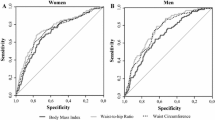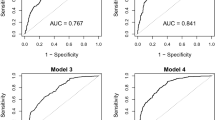Abstract
This study aimed to assess the predictive value of anthropometric measurements in impaired fasting glucose progression to type 2 diabetes (T2DM) after 9 years of follow-up in the Prospective Urban and Rural Epidemiology (PURE) study run in Poland. The study group consisted of 283 patients aged 54.3 ± 8.9 years who had impaired fasting glucose at baseline and completed a 9-year-long follow-up. We analyzed body weight, height, waist (WC) and hip (HC) circumferences, waist-to-hip ratio (WHR), waist-to-height ratio (WHtR), body mass index (BMI), and body adiposity index (BAI). Most individuals were overweight or obese according to BMI. Obesity occurred more often in men than women. The analysis highlighted the following three anthropometric parameters WHtR, BMI, and WC, each having equally good predictive power concerning the development of full-fledged T2DM in people with impaired fasting glucose. In conclusion, we confirmed the distinct harmfulness of obesity and pointed out the potential of easy-measured anthropometric parameters to self-control the risk of passing the impaired fasting glucose into T2DM.
Access this chapter
Tax calculation will be finalised at checkout
Purchases are for personal use only
Similar content being viewed by others
References
Alberti KG, Zimmet P, Shaw J (2006) Metabolic syndrome – new worldwide definition. A consensus statement from the international diabetes federation. Diabet Med 23(5):469–480
Ashwell M, Gibson S (2014) A proposal for a primary screening tool: ‘keep your waist circumference to less than half your height. BMC Med 12(1):1–6
Ashwell M, Gunn P, Gibson S (2012) Waist-to-height ratio is a better screening tool than waist circumference and bmi for adult cardiometabolic risk factors: systematic review and meta-analysis. Obes Rev 13(3):275–286
Bennasar-Veny M, Lopez-Gonzalez AA, Tauler P, Cespedes ML, Vicente-Herrero T, Yañez A, Tomas-Salva M, Aguilo A (2013) Body adiposity index and cardiovascular health risk factors in Caucasians: a comparison with the body mass index and others. PLoS One 8(5):e63999
Bergman RN, Stefanovski D, Buchanan TA, Sumner AE, Reynolds JC, Sebring NG, Xiang AH, Watanabe RM (2011) A better index of body adiposity. Obesity (Silver Spring) 19(5):1083–1089
Corsi DJ, Subramanian SV, Chow CK, McKee M, Chifamba J, Dagenais G, Diaz R, Iqbal R, Kelishadi R, Kruger A, Lanas F, López-Jaramilo P, Mony P, Mohan V, Avezum A, Oguz A, Rahman MO, Rosengren A, Szuba A, Li W, Yusoff K, Yusufali A, Rangarajan S, Teo K, Yusuf S (2013) Prospective Urban Rural Epidemiology (PURE) study: baseline characteristics of the household sample and comparative analyses with national data in 17 countries. Am Heart J 166(4):636–646.e4
Dagenais GR, Gerstein HC, Zhang X et al (2016) Variations in diabetes prevalence in low-, middle-, and high-income countries: results from the prospective urban and rural epidemiological study. Diabetes Care 39(5):780–787
Després JP (2012) Body fat distribution and risk of cardiovascular disease: an update. Circulation 126(10):1301–1313
Dong J, Ni YQ, Chu X, Liu YQ, Liu GX, Zhao J, Yang YB, Yan YX (2016) Association between the abdominal obesity anthropometric indicators and metabolic disorders in a Chinese population. Public Health 131:3–1
Eades CE, France EF, Evans JMM (2016) Prevalence of impaired glucose regulation in Europe: a meta-analysis. Eur J Pub Health 26(4):699–706
Færch K, Witte DR, Tabák AG, Perreault L, Herder C, Brunner EJ, Kivimäki M, Vistisen D (2013) Trajectories of cardiometabolic risk factors before diagnosis of three subtypes of type 2 diabetes: a post-hoc analysis of the Longitudinal Whitehall II Cohort Study. Lancet Diabetes Endocrinol 1(1):43–51
Garber AJ, Handelsman Y, Einhorn D, Bergman DA, Bloomgarden ZT, Fonseca V, Garvey WT, Gavin JR 3rd, Grunberger G, Horton ES, Jellinger PS, Jones KL, Lebovitz H, Levy P, McGuire DK, Moghissi ES, Nesto RW (2008) Diagnosis and management of prediabetes in the continuum of hyperglycemia: when do the risks of diabetes begin? A consensus statement from the American College of Endocrinology and the American Association of Clinical Endocrinologists. Endocr Pract 14(7):933–946
Gastaldelli A, Gaggini M, DeFronzo RA (2017) Role of adipose tissue insulin resistance in the natural history of type 2 diabetes: results from the San Antonio Metabolism Study. Diabetes 66(4):815–822
IDF (2019) International Diabetes Federation. Diabetes Atlas 2019. Ninth Edition 2019. https://www.idf.org/about-diabetes/facts-figures; accessed on 4 October 2021
Lam BC, Koh GC, Chen C, Wong MT, Fallows SJ (2015) Comparison of body mass index (BMI), body adiposity index (BAI), waist circumference (WC), waist-to-hip ratio (WHR) and waist-to-height ratio (WHtR) as predictors of cardiovascular disease risk factors in an adult population in Singapore. PLoS One 10(4):e0122985
NIH (2000) National Institute of Health. The Practical Guide Identification, Evaluation, and Treatment of Overweight and Obesity in Adults
Okorodudu DO, Jumean MF, Montori VM, Romero-Corral A, Somers VK, Erwin PJ, Lopez-Jimenez F (2010) Diagnostic performance of body mass index to identify obesity as defined by body adiposity: a systematic review and meta-analysis. Int J Obes 34(5):791–799
Richter B, Hemmingsen B, Metzendorf MI, Takwoingi Y (2018) Development of type 2 diabetes mellitus in people with intermediate hyperglycaemia. Cochrane Database Syst Rev 10(10):CD012661
Schulze MB, Thorand B, Fritsche A, Häring HU, Schick F, Zierer A, Rathmann W, Kröger J, Peters A, Boeing H, Stefan N (2012) Body adiposity index, body fat content and incidence of type 2 diabetes. Diabetologia 55(6):1660–1667
Stepaniak U, Micek A, Waśkiewicz A, Bielecki W, Drygas W, Janion M, Kozakiewicz K, Niklas A, Puch-Walczak A, Pająk A (2016) Prevalence of general and abdominal obesity and overweight among adults in Poland. Results of the WOBASZ II study (2013–2014) and comparison with the WOBASZ study (2003–2005). Pol Arch Med Wewn 126(9):662–671
Święcicka-Klama A, Połtyn-Zaradna K, Szuba A, Zatońska K (2021) The natural course of impaired fasting glucose. Adv Exp Med Biol 1324:41–50
Teo K, Chow CK, Vaz M, Rangarajan S, Yusuf S, PURE Investigators-Writing Group (2009) The Prospective Urban Rural Epidemiology (PURE) study: examining the impact of societal influences on chronic noncommunicable diseases in low-, middle-, and high-income countries. Am Heart J 158(1):1–7.e1
Vinknes KJ, Elshorbagy AK, Drevon CA, Gjesdal CG, Tell GS, Nygård O, Vollset SE, Refsum H (2013) Evaluation of the body adiposity index in a Caucasian population: the Hordaland health study. Am J Epidemiol 177(6):586–592
WHO (2000) Obesity: preventing and managing the global epidemic. Report of a WHO Consultation. WHO technical report series, vol 894
WHO (2008) Waist circumference and waist-hip ratio. Report of a WHO Expert Consultation. World Health Organization
Zatońska K, Ilow R, Regulska-Ilow B, Różańska D, Szuba A, Wołyniec M, Einhorn J, Vatten L, Asvold BO, Mańczuk M, Zatoński WA (2011) Prevalence of diabetes mellitus and IFG in the prospective cohort PONS study - baseline assessment. Ann Agric Environ Med 18(2):265–269
Zatońska K, Połtyn-Zaradna K, Einhorn J, Wołyniec M, Gaweł-Dąbrowska D, Szuba A, Zatoński W (2017) Differences in prevalence of diabetes mellitus type 2 and impaired fasting glucose between urban and rural areas according to PURE Poland substudy. Int J Diabetes Dev Ctries 37(3):305–312
Zatońska K, Basiak-Rasała A, Rózańska D, Karczewski M, Wołyniec M, Szuba A, Połtyn-Zaradna K (2020) Changes in diabetes prevalence and corresponding risk factors -findings from 3- and 6-year follow-up of PURE Poland Cohort Study. BMC Public Health 20(843):1–9
Zdrojowy-Wełna A, Zatońska K, Bednarek-Tupikowska G, Jokiel-Rokita A, Kolackov K, Szuba A, Bolanowski M (2018) Determinants of obesity in population of PURE study from lower Silesia. Endokrynol Pol 69(6):644–652
Acknowledgments
The PURE study and its components were funded by the Population Health Research Institute, the Canadian Institutes of Health Research, and Heart and Stroke Foundation of Ontario and through unrestricted grants from several pharmaceutical companies. The Polish ramification of the PURE study was co-funded by the Polish Ministry and Science and Higher Education (grant no. 290/W-PURE/ 2008/0) and Wroclaw Medical University (grant no. SUB.C300.21.009).
Conflicts of Interest
The authors declare no conflicts of interest concerning this article.
Ethical Approval
All procedures performed in studies involving human participants followed the ethical standards of the institutional and/or national research committee and with the 1964 Helsinki declaration and its later amendments or comparable ethical standards. The study was approved by the Bioethics Committee of Wroclaw Medical University (permit no. KB-443/2006).
Informed Consent
Written informed consent was obtained from all individual participants included in the study.
Author information
Authors and Affiliations
Corresponding author
Editor information
Editors and Affiliations
Rights and permissions
Copyright information
© 2021 The Author(s), under exclusive license to Springer Nature Switzerland AG
About this chapter
Cite this chapter
Święcicka-Klama, A., Połtyn-Zaradna, K., Wołyniec, M., Szuba, A., Zatońska, K. (2021). Anthropometric Indices as Long-Term Predictors of Diabetes in Impaired Fasting Glucose Metabolism: Findings in the PURE Study in Poland. In: Pokorski, M. (eds) Integrative Clinical Research. Advances in Experimental Medicine and Biology(), vol 1375. Springer, Cham. https://doi.org/10.1007/5584_2021_681
Download citation
DOI: https://doi.org/10.1007/5584_2021_681
Published:
Publisher Name: Springer, Cham
Print ISBN: 978-3-030-99629-1
Online ISBN: 978-3-030-99630-7
eBook Packages: Biomedical and Life SciencesBiomedical and Life Sciences (R0)




